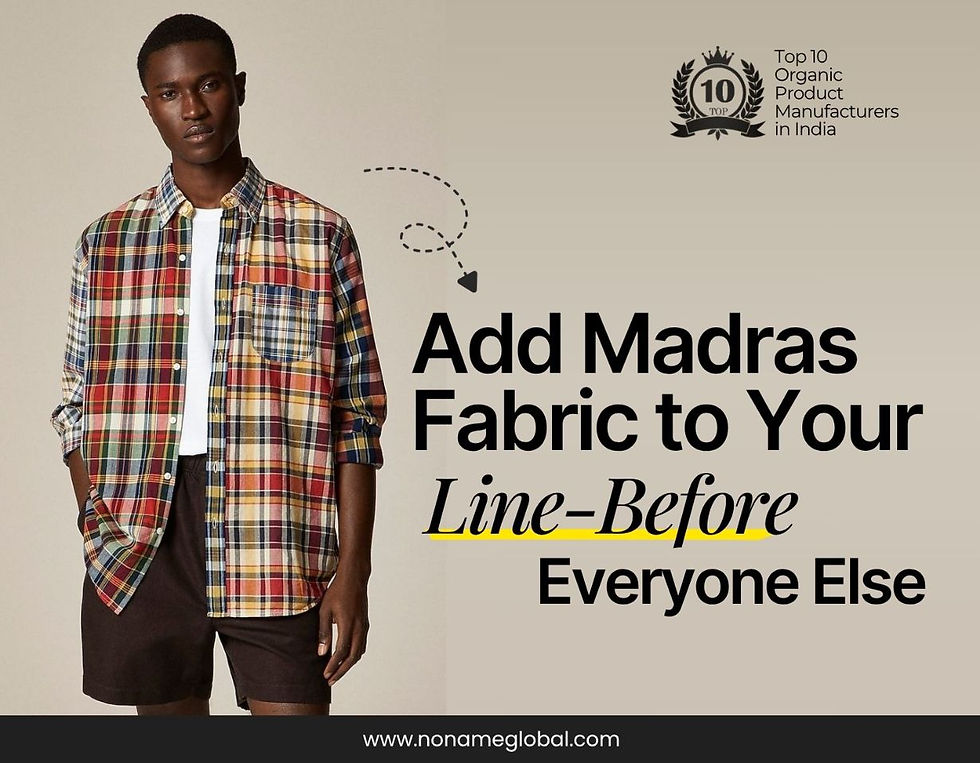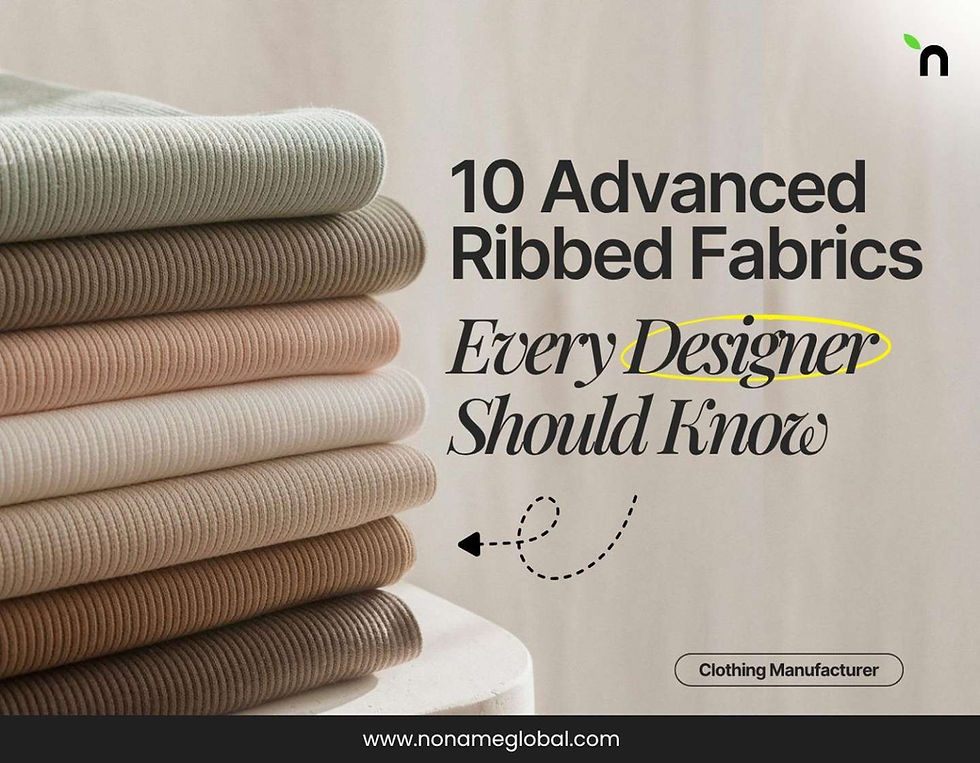Why Cambric Fabric Needs Gentle Stitching
- Shraddha Srivastava
- Jul 28
- 7 min read
Updated: Aug 5
Summary:
Cambric fabric is soft and stylish but tricky to stitch due to its lightweight and tight weave. This blog explains why gentle stitching is a must and how expert garment manufacturers in India—like NoName—handle it right. If you’re looking to use Cambric fabric in your next collection, read on to avoid costly stitching mistakes!
Introduction:
Soft on skin, tough in production.
That’s the paradox of Cambric fabric—a fine, tightly woven material loved by designers and dreaded (just a little) by production managers. Its delicate texture and elegant drape make it a favorite for summer wear, baby clothing, and casual luxury, but behind its lightweight charm lies a stubborn truth: Cambric needs gentle stitching.

In this blog, we’ll unpack why Cambric fabric is so challenging to stitch, explore special techniques used by professional garment manufacturers, and show how leading names like NoName handle this fabric with finesse.
Whether you’re a fashion brand sourcing private-label clothing or a designer curious about construction, this guide will help you appreciate the craft behind Cambric clothing.
What Is Cambric Fabric?
Cambric is a lightweight, plain-weave cotton fabric with a soft hand feel and subtle sheen. Originally made from linen in Cambrai, France, today’s Cambric is typically cotton-based. Its tightly woven threads give it strength and a polished look, yet it remains breathable, making it perfect for hot and humid climates.
Key Features:
Smooth surface
Soft and skin-friendly
Tightly woven but lightweight
Easily dyeable and printable
Mild sheen, elegant appearance
Why Is It Difficult to Stitch Cambric Fabric?

Cambric fabric is celebrated for its soft texture, clean finish, and breathability, but when it comes to stitching, this seemingly simple fabric can become surprisingly complex. Especially in high-volume garment manufacturing setups, Cambric presents several technical challenges that demand expert handling.
Let’s explore the stitching-related issues with Cambric fabric in depth:
1. Low Fabric Weight – Too Light for Pressure
Cambric typically ranges between 80 to 130 GSM (grams per square meter), making it one of the lighter plain-weave cotton fabrics available in the apparel industry. This lightweight nature is great for comfort, but problematic for industrial stitching.
Problem: The fabric shifts or gets pulled unevenly under the sewing machine’s feed dogs and presser foot.
Result: Misaligned panels, off-grain seams, and inconsistent stitching.
In Production: Manufacturers may need to reduce machine speed or use top-feeding systems to ensure the fabric stays in place.
2. Tightly Woven Structure – Strong Yet Sensitive
Cambric has a tight weave structure, often woven at 80–100 threads per inch, giving it a dense, fine finish. While this helps with durability and print quality, it creates resistance to needle penetration.
Problem: Standard needles pierce the threads, causing visible puncture holes or microtears in the weave.
Result: Weakened seams and visible stitch marks on the garment surface.
Industry Practice: Manufacturers switch to microtex or ballpoint needles (size 9 or 11), which are thinner and reduce surface damage.
3. Smooth Texture – Hard to Control
Cambric is finished to have a smooth, slightly glossy surface, which makes it prone to slipping or shifting during sewing.
Problem: Stitching becomes inaccurate, especially at corners or curved seams.
Result: Crooked topstitching, mismatched prints, and uneven hems.
Solution: To minimize shifting, temporary stabilizers, tissue paper, or fine basting are used during assembly.
4. Fraying Edges – Subtle but Persistent
Cambric frays along the cut edges, especially in areas with no lining or binding. The fine threads unravel more during handling and movement.
Problem: The cut edges start to shed fine fibers, increasing fabric wastage.
Result: Seams can come apart post-wash or look unfinished without edge reinforcement.
Garment Manufacturing Tip: Overlocking or French seams are commonly used to contain fraying and extend garment life.
5. High Risk of Puckering – Stitching Gone Wrong
Puckering happens when the fabric gathers along the seam due to improper stitching tension or stitch density. In Cambric, this risk is significantly higher due to the lightweight and tight weave.
Problem: Even a minor increase in thread tension or reduction in stitch length can pull the fabric excessively.
Result: The seam looks wrinkled, especially after washing or ironing.
Stat Insight: Studies show puckering rates in Cambric can be 30–40% higher than in medium-weight cottons if tension settings are not adjusted.
Solution: Use a stitch length of 2.0–2.5 mm with low thread tension for the best results.
6. Needle Marks on Finished Garments – No Room for Error
Once a needle punctures Cambric, the mark is often permanent. This is especially critical in sample development, embroidery, or decorative topstitching.
Problem: Stitch corrections or alterations leave visible holes.
Result: Lower aesthetic quality and rework costs increase.
Industry Practice: High-precision stitching tools and "first-time right" execution are prioritized to avoid corrections.
7. Difficulty in Handling Decorative Elements
Cambric doesn’t support heavy embroidery or embellishments very well due to its lightweight and limited stretch.
Problem: Heavy beading, 3D appliqués, or dense threadwork can pull down the fabric.
Result: Garments sag, lose structure, or tear at the embellishment points.
Manufacturer's Approach: Use lightweight embroidery threads and water-soluble stabilizers to distribute weight and prevent distortion.
8. Shrinkage During Finishing – The Silent Killer
If not pre-treated, Cambric can shrink by 3–7% during garment washing or steam finishing, depending on the quality of the yarn and weave tightness.
Problem: Panels stitched before shrinkage become uneven in size.
Result: Seams twist, fit issues arise, and the garment loses shape after the first wash.
Solution: Pre-shrinking (sanforizing) and pressing are essential steps before cutting and stitching.
Types of Gentle Stitches Used for Cambric Clothing
To overcome these challenges, expert garment manufacturers in India adopt specific, gentle stitching techniques that preserve the structure and appearance of Cambric garments.
Let’s explore the most effective ones:
1. Lock Stitch with Fine Needle
Description: A straight stitch done using very fine needles (size 9 or 11).
Used For: Shirts, babywear, linings.
Advantage: Penetrates the fabric with minimal damage; delivers clean, flat seams.
2. French Seams
Description: A seam technique that encloses the raw edges between two rows of stitching.
Used For: Women’s blouses, premium baby clothing, nightwear.
Advantage: Prevents fraying and adds a luxury finish to delicate apparel.
3. Flat-Felled Seams
Description: Similar to denim stitching but done with finer threads on lightweight fabrics.
Used For: Casual shirts, day dresses.
Advantage: Strong, flat seams that don't irritate the skin or bulk up the garment.
4. Overlock Edging
Description: A 3- or 4-thread edge-finishing stitch done by a serger.
Used For: Seam allowances in mass-produced garments.
Advantage: Controls fraying while allowing for quicker production cycles.
5. Blind Hem Stitch
Description: A partially hidden stitch used for hems that shouldn’t show from the outside.
Used For: Dresses, skirts, and women’s formalwear.
Advantage: Maintains the smooth look of Cambric’s fall without visible thread lines.
Additional Gentle Stitching Techniques
6. Twin Needle Stitching
Application: Used for structured hems on dresses and tunics.
Benefit: Creates double rows of parallel stitches that add structure without pulling the fabric.
7. Stay Stitching
Application: Applied along curves like necklines and armholes.
Benefit: Prevents stretching on bias edges and keeps garment shape intact during assembly.
8. Rolled Hem
Application: Perfect for scarves, airy blouses, and light dresses.
Benefit: Creates a fine, narrow hem that’s almost invisible, allowing Cambric’s soft texture to shine.
Production Tip
Always pre-wash and press Cambric fabric before cutting and stitching. This ensures:
Accurate pattern alignment
Reduced puckering and shrinkage post-stitching
Seam durability and garment shape retention
This single step can reduce post-production rework by up to 10% and drastically improve customer satisfaction in finished garments.
Is Cambric Fabric Sustainable?
With the world moving toward eco-conscious fashion, Cambric holds potential, but it depends on the source.
When Is Cambric Sustainable?
If made from organic cotton
Dyed with low-impact or azo-free dyes
Produced in closed-loop or water-efficient processes
Sustainable Cambric is biodegradable, renewable, and energy-efficient to launder, making it a viable choice for sustainable clothing manufacturers in India.
When It’s Not
If Cambric is treated with heavy chemicals or blended with non-biodegradable fibers (like polyester), its sustainability drops. Responsible sourcing is key.
The Best Clothing Manufacturer in India for Cambric Fabric
At NoName, we understand the complexity and beauty of working with Cambric fabric. As a sustainable clothing manufacturer in India with years of experience in fine cottons and technical fabrics, we specialize in gentle, precise stitching techniques that preserve the elegance of Cambric without compromising on durability.
Whether you’re looking to develop:
A private-label Cambric clothing line
Eco-friendly women’s summer wear
Small-batch babywear orders
Or customized garments with Flexi MOQ
NoName delivers uncompromised quality. We don’t just stitch Cambric garments—we engineer them for comfort, style, and longevity.
Our range of Cambric fabric clothing includes:
Women’s blouses and tops
Breathable summer dresses and tunics
Men’s lightweight shirts
Stylish and comfortable baby frocks and rompers
Nightwear and loungewear sets
Kurti linings and soft inner layers
Resort wear and travel-friendly casuals
Every piece we produce is crafted to meet the highest standards of finish, fit, and feel, making NoName the go-to partner for brands seeking a reliable, private-label clothing manufacturer in India for Cambric-based garments.
Why Fashion Brands Prefer Cambric for Clothing
For boutique labels and D2C brands, Cambric offers the perfect blend of cost-efficiency and luxury feel. Here's why:
Affordable raw material
High dye affinity for bright, lasting prints
Skin-friendly, ideal for sensitive customers
Works well with delicate embellishments like lace or embroidery
Faster drying and easy to pack, perfect for resort or summer wear collections
But only a skilled private-label clothing manufacturer in India like NoName can balance all these benefits while ensuring top-tier garment quality.
Final Thoughts: Gentle Stitching, Great Fashion
Cambric may look like just another cotton fabric, but behind every beautiful Cambric blouse or baby frock lies technical excellence, experience, and attention to detail. The fabric demands gentle stitching, but when handled right, it delivers luxury at an affordable scale.
For fashion brands looking to make a mark, Cambric is a material worth considering—but only when you have the right manufacturing partner.
Let NoName Handle Your Next Cambric Collection
If you’re searching for a garment manufacturer in India that understands how to work with delicate fabrics like Cambric, NoName is your answer. We bring together:
Expert stitching techniques
Eco-conscious production
Low minimum order quantities (Flexi MOQ)
Custom design and private-label capabilities
👉 Contact us today to develop your next collection in Cambric fabric—stitched with care, crafted with passion.
WhatsApp: +91-9717 508 508
Email: hello@nonameglobal.com
Website: www.nonameglobal.com
Online meeting: https://calendly.com/nonameglobal/meet














Comments